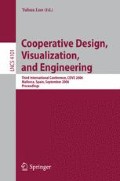Abstract
The major problem for investors in construction area is to choose the financially effective construction alternative, most often associated with underestimated actual demand for resources. The lack of information feedback among all participants of the project and the uncertainty treats at the design and construction stages are presented in this paper. Solution is the theoretical 3D building information model, combined with resource demand calculations, comparison of alternatives and determination the duration of all construction project life stages. The software based on this aggregate 4D PLM model can be the mean of effective management of the construction project, embracing planning, design, economic calculations, construction, management, usage and maintenance of the completed building. The paper also describes multiple criteria evaluation software used to identify the most effective construction alternative with presented suggestions of implementation in practice.
Access this chapter
Tax calculation will be finalised at checkout
Purchases are for personal use only
Preview
Unable to display preview. Download preview PDF.
References
Ford, S., Aouad, G., Brandon, P., Brown, F., Child, T., Cooper, G., Kirkham, J., Oxman, R., Young, B.: The object oriented modeling of building design concepts. Building and Environment 29(4), 411–419 (1994)
Donath, D., Loemker, T.M., Richter, K.: Plausibility in the planning process – reason and confidence in the computer-aided design and planning of buildings. Automation in Construction 13(2), 159–166 (2004)
Sacks, R., Eastmanand, C.M., Lee, G.: Parametric 3D modeling in building construction with examples from precast concrete. Automation in Construction 13(3), 291–312 (2004)
Ustinovičius, L., Popov, V., Migilinskas, D.: Automated management, modeling and choosing of economically effective variant in construction. Transport and Telecommunication 6(1), 183–189 (2005)
Ekholm, A., Fridqvist, S.: A concept of space for building classification, product modelling, and design. Automation in Construction 9(3), 315–328 (2000)
Leinonen, J., Kähkönen, K.: New construction management practice based on the virtual reality technology. In: Issa, R.R.A., Flood, I., O’Brien, W.J. (eds.) 4D CAD and Visualization in Construction, pp. 75–100. A.A. Balkema Publishers, Lisse (2003)
Chantawit, D., Hadikusumo, B.H.W., Charoenngam, C.: 4D CAD-Safety: visualizing project scheduling and safety planning. Construction Innovation 5(2), 99–114 (2005)
Aouad, G., Marir, F., Child, T., Brandon, P., Kawooya, A.: Construction Integrated Databases - Linking design, planning and estimating, The OSCON approach. In: International Conference on the Rehabilitation and Development of Civil Engineering Infrastructures, American University of Beirut, pp. 52–60 (1997)
de Vries, B., Broekmaat, M.: Implementation Scenarios for 4D CAD in Practice. In: Maas, G., van Gassel, F. (eds.) Proceedings of the 20th International Symposium on Automation and Robotics in Construction, Eindhoven University of Technology, Eindhoven, pp. 393–398 (2003)
Zavadskas, E.K., Ustinovichius, L., Turskis, Z., Peldschus, F., Messing, D.: LEVI-3.0 – multiple criteria evaluation program for construction solutions. Journal of Civil Engineering and Management 8(2), 184–191 (2002)
Nowak, M.: Investment projects evaluation by simulation and multiple criteria decision aiding procedure. Journal of Civil Engineering and Management 11(3), 193–202 (2005)
van Leeuwen, J.P., van der Zee, A.: Distributed Object Models for Collaboration in the Construction Industry. Automation in Construction 14(4), 491–499 (2005)
Migilinskas, D.: The influence of normalization methods selection in construction including game theory adaptation. Technological and economic development of economy 9(2), 73–79 (2003)
Maute, K., Raulli, M.: An interactive method for the selection of design criteria and the formulation of optimization problems in computer aided optimal design. Computers & Structures 82(1), 71–79 (2004)
Garner, B., Raban, R.: Context management in modeling information systems (IS). Information and Software Technology 41(14), 957–961 (1999)
Dijkstra, J., van Leeuwen, J.P., Timmermans, H.J.P.: Evaluating Design Alternatives Using Conjoint Experiments in Virtual Reality. Environment and Planning 30, 357–367 (2003)
Popov, V., Mikalauskas, S., Migilinskas, D., Vainiunas, P.: Complex usage of 4D information modeling concept for building design, estimation, scheduling and determination of effective variants. Technological and economic development of economy 12 (2006)
Borg, J., Yan, X.T., Juster, N.P.: Exploring Decisions Influence on Life-Cycle Metrics to Aid Design for Multi-X. Artificial Intelligence for Engineering Design, Analysis and Manufacture 14(2), 91–113 (2000)
Aouad, G., Sun, M., Faraj, I.: Computer integrated construction: recent developments and future directions. In: Topping, B.H.V. (ed.) Civil and Structural Engineering Computing: 2001, pp. 27–54. Saxe-Coburg Publications, UK (2001)
Migilinskas, D., Ustinovichius, L.: An analysis of inaccuracy effect in solving construction technology and economy problems, applying games theory. In: The 8th International Conference Modern building materials, structures and techniques, Selected papers (VGTU, Vilnius, Lithuania), pp. 229–235 (2004)
Sarka, V.: A Decision Support System Applying Multicriteria Synthesis Methods in Construction. Statyba (Civil Engineering and Management) 6(6), 464–468 (2000)
Ustinovichius, L.: Determination of Efficiency Of Investments In Construction. International Journal of Strategic Property Management 8(1), 25–44 (2004)
Author information
Authors and Affiliations
Editor information
Editors and Affiliations
Rights and permissions
Copyright information
© 2006 Springer-Verlag Berlin Heidelberg
About this paper
Cite this paper
Migilinskas, D., Ustinovichius, L. (2006). Computer-Aided Modelling, Evaluation and Management of Construction Projects According to PLM Concept. In: Luo, Y. (eds) Cooperative Design, Visualization, and Engineering. CDVE 2006. Lecture Notes in Computer Science, vol 4101. Springer, Berlin, Heidelberg. https://doi.org/10.1007/11863649_30
Download citation
DOI: https://doi.org/10.1007/11863649_30
Publisher Name: Springer, Berlin, Heidelberg
Print ISBN: 978-3-540-44494-7
Online ISBN: 978-3-540-44496-1
eBook Packages: Computer ScienceComputer Science (R0)

